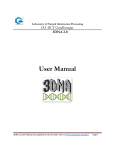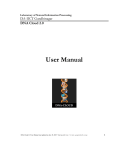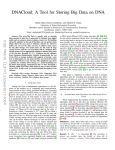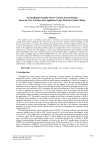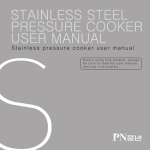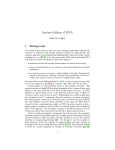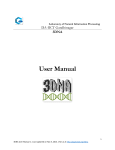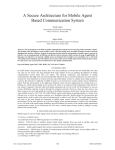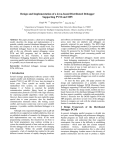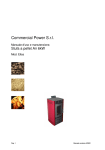Download uSER MANUAL
Transcript
Laboratory of Natural Information Processing DA-IICT Gandhinagar DNA Pen User Manual 0 | Page DNA Pen User Manual 1.0 Last updated on August 29, 2013. Visit us at h t t p : / / w w w . g u p t a l a b . o r g DNA Pen User Manual © 2013 Manish K Gupta, Laboratory of Natural Information Processing DA-IICT, Gandhinagar, Gujarat 382007 http://www.guptalab.org/dnapen The software described in this book is furnished under an open source license agreement and may be used only in accordance with the terms of the agreement. Any selling or distribution of the program or its parts, original or modified, is prohibited without a written permission from Manish K Gupta. Documentation version 1.0 This file was last modified on August 29, 2013. . Credits & Team Principle Investigator: Manish K. Gupta, PhD. Graduate Mentor: Dixita Limbachiya Developers: Arnav Goyal, Shikhar Kumar Gupta, Foram Joshi, Sushant Pritmani & Akshita Sahai Software Logo: Foram Joshi Acknowledgments The authors would like to thank Priyanka Shukla and Sonam Jain for providing the module to generate error free DNA sequences and Bruno Lowagie (http://itextpdf.com) whose free open source libraries have been used for generating bar codes and PDF. We thanks GLYPHICONS free for providing us icons.( http://glyphicons.com/) 1 | Page DNA Pen User Manual 1.0 Last updated on August 29, 2013. Visit us at h t t p : / / w w w . g u p t a l a b . o r g Table of contents General Information 03 1. Introduction 2. Overview 3. Product Scope 4. Product Perspective System Summary 04 Getting Started 04 Free-hand Molecular Canvas Digitized Molecular Canvas Save Detailed DNA Data Save DNA Sequence Save PDF Create Latex file View Draw Image Edit Dimension Estimator Capture Canvas Screenshot Clear Social Media Help 05 06 07 09 10 Support and Feedback 11 References 11 2 | Page DNA Pen User Manual 1.0 Last updated on August 29, 2013. Visit us at h t t p : / / w w w . g u p t a l a b . o r g General Information 1. Introduction DNA is a fundamental unit of any organism, which makes it the most intriguing and exciting option available for construction of nanostructure. Due to its specificity of the base pairing, it weaves itself in to the target structures at nano level. DNA origami [1] is a simple method used to construct complex two-dimensional (2D) and three-dimensional (3D) structures by DNA self-assembly [2]. However, conducting random experiments for constructing such structures is exhaustive and expensive, hence, there is need to develop the software for such nanoscale construction. DNA Pen is one such tool for creation of two dimensional DNA nanostructures which employs the idea of DNA Bricks [3] [4]. Desired shapes are created on the molecular canvas and the respective sequences required for the building of the shapes is generated as output. It generates error free DNA sequence with the error correction and stability modules [5]. By the designing of the structures, visualizing the structure, the software increase the efficiency and productivity of the nano scale construction 2. Overview DNA Pen has been primarily developed to facilitate the construction of nanostructures by DNA Brick. The software encourages the users to first visualize the structures, draw them accordingly on a virtual sheet and then generates the required DNA strand sequence. By this we not only achieve automation but also minimize the need for repetitive experimentation for developing one structure. The reduction in exhaustion is because of two processes that the software undertakes. The software is able to give infinite number of DNA strand sequences for the same shape. It allows user to choose to variety of DNA strands for the experiments. 3. Product Scope This software provides the user with: Visualization and list of DNA strand sequences for DNA Bricks of different dimensions. Visualization and list of DNA Brick sequences for 2D structures drawn on a free-hand draw grid. Visualization and list of DNA strand sequences for 2D structures drawn on a digital grid. (Each cell in the grid represents one tile of DNA Brick) DNA Pen checks for the thermal stability of the DNA strand sequences generated. Also it makes sure that there are no possibilities for any kind of secondary structures being formed. The strings then go through a refined process to ensure that they satisfy the constraints for error-correcting codes. 3 | Page DNA Pen User Manual 1.0 Last updated on August 29, 2013. Visit us at h t t p : / / w w w . g u p t a l a b . o r g 4. Product Perspective This product’s main aim is to make the process of making the computerization and computation of DNA Origami structure user friendly. System Summary Operating Systems – Windows 7, Mac OS X This software requires the system to have specifications similar to: - 2.4 GHz Core 2 Duo, 100 MB Hard Disk, 2GB Random Access Memory and Basic peripherals like keyboard, mouse etc. Getting Started Once you have successfully installed the software, open DNA pen by double clicking on the icon available on your desktop screen, a window with four menu options on the menu bar will appear. The dialogue box generating the random tips will appear that will guide the user about the software utility. It includes the button for creating the new project. User can click on this button or can select the option “Create a new project” from the file menu. This will open the dialogue box that will ask to enter the name of the project. Once user specifies the name, select the path to save the project at specific location and click on “create” button. Once you save the project folder at specified location, this folder consists of all the output files of your project. The main features that the software provides the user with and which are spanned across these four options on the menu bar are: Work on Free-hand Molecular Canvas Work on Digitized Molecular Canvas Save Detailed DNA Data Save DNA Sequence Save PDF Create Latex file View Draw Image Edit Dimension Estimator Capture Canvas Screenshot Clear Social Media 4 | Page DNA Pen User Manual 1.0 Last updated on August 29, 2013. Visit us at h t t p : / / w w w . g u p t a l a b . o r g 1. Free Hand Molecular Canvas This option is available under the tools menu of the menu bar. When the user clicks on “Tools > Free Hand Molecular Canvas”, the display area on the DNA Pen’s home window where user can draw the 2D structure he wants to create. Using this molecular canvas is very easy; a simple mechanism is to be followed. The user has to click and drag the mouse simultaneously on the canvas in accordance with the shape that he wants to create. It works just like drawing tool Paint, where you can draw any shape. If you want erase some you can select Erase button on right hand top corner of the screen. To again start drawing select Pen mode by Pen button next to erase button. Figure 1 is the example of the hindi letter “OM” created on the free hand molecular canvas. User can draw any free hand shape he wishes to built at nano scale on this free hand molecular canvas. Eraser mode Figure 1 Free Hand Molecular Canvas 2. Digitized Molecular Canvas This option is available under the tools menu of the menu bar. When the user clicks on the “Tools-> Digitized Molecular Canvas”, the display area on the DNA Pen’s home window would be filled up with a gridded canvas. Here the canvas would be filled with cells which are bigger in size as compared to the cells available in Free Hand Molecular Canvas. The user simply needs to click on the cell that he wants to be a part of his structure. The cell gets highlighted as the user clicks on it. Figure 2 is the example of the nano shape of Cross designed on the 5 | Page DNA Pen User Manual 1.0 Last updated on August 29, 2013. Visit us at h t t p : / / w w w . g u p t a l a b . o r g digitized canvas. There is an undo option available in the tools which enable the user to undo the designed once built. Also by clicking twice on the cell it will de-highlight the cell. Figure 2: Digitized Molecular Canvas 3. Save Detailed DNA Data This option is available under the File menu of the menu bar. When the user clicks on “File -> Save Detailed DNA Data”, DNA Pen checks whether the user has created a design on either of the two molecular canvases available. The software saves an excel file which contains an ordered list of the DNA strand sequences required to make such a structure experimentally and coordinates of the tile used to generate the shape. A pop-up window is generated that confirms that file is saved successfully at specified location with the name DNAData_filename. Figure 3 shows the way to save the designed shape, which will generate the sequence to for the designed shape. 4. Save DNA Sequence This option is available under the File menu of the menu bar. When the user clicks on “File -> Save DNA Sequence”, DNA Pen checks whether the user has created a new Brick and changed the dimensions from the default values. The software saves an excel file which contains an ordered list of the DNA strand sequences used to make the Brick. A pop-up window is generated that confirms that file is saved successfully at specified location with the name DNAData_filename. 6 | Page DNA Pen User Manual 1.0 Last updated on August 29, 2013. Visit us at h t t p : / / w w w . g u p t a l a b . o r g Figure 3: Save detailed DNA option generate DNA sequences 5. Save PDF This option includes all the output in one PDF. Once you draw the shape on the canvas, click on this option. It will include the barcode number which is unique to all the shapes drawn by the user. This will help to identify the shapes drawn by him uniquely. It will include image of the structure designed in the canvas, dimension of the brick and brick image. This all are the output in one page which will help user to understand it better. A pop-up window is generated that confirms that file is saved successfully at specified location with the name FreeGridData_filename (If user had drawn on freehand molecular canvas) and DigitizedGridData_filename. 6. Create Latex File This option includes all the latex file of the DNA sequence and its related information like total number of half tile and full tiles and total DNA sequences generated.in one PDF. Once you save the DNA sequences, click on this option. This will create the latex folder which include image of the shape and PDF that includes all the DNA sequences in well-organized tabular format. All are the output in one folder which will help user to understand it better. 7. View Draw Image This option will generate the image of the shape drawn. It will display the tiles arranged in specific manner according to the shape drawn on the molecular canvas. This will allow the 7 | Page DNA Pen User Manual 1.0 Last updated on August 29, 2013. Visit us at h t t p : / / w w w . g u p t a l a b . o r g user to understand how the specific shape gets arranged according the design of the single stranded tiles. Figure 4 displays the arrangement of the SST for the shape in figure 3. Figure 4 SST arrange in specific manner by view draw image option 8. Edit Dimensions This option is available on the menu bar under the Edit menu. When the user clicks on “Edit > Edit Dimensions” a small pop up window opens up where the user can select any dimensions from dropdown options. The pop-up has 2 buttons at the bottom of the window, the “Save” and the “Cancel” button. The Save button saves the dimensions of the brick created and now if the user works on the molecular canvas, the bricks used in the backend would be of the dimensions as specified by the user. Figure 5 shows the dialouge box appear when user wish to change the brick dimension. 9. Estimator This option is available on the menu bar under the Tools menu. When the user clicks on “Tools-> Estimator” a small pop up window opens up where the user can enter the cost per base of DNA. This will give you total cost of the DNA sequences used to generate DNA sequences in US dollar (USD). 8 | Page DNA Pen User Manual 1.0 Last updated on August 29, 2013. Visit us at h t t p : / / w w w . g u p t a l a b . o r g Figure 5 Dimensions for the free grid molecular canvas . 10. Capture the screenshot This will take the screenshot of the canvas. It is available in Tools menu. This will ask user to save the screenshot at user choice destination. 11. Clear This will clear your shapes drawn on the molecular canvas. 12. Social Media This provides links to follow us on the social media websites. You can follow DNA Pen at Facebook, Twitter, Quora and You tube. Output Once you save the draw data, the output generated is in the excel format. The destination place which you have selected to save the draw data, contains the excel file. Double click on the file to open it. It gives the information about the base sequences required for the shape designed. Also it includes the sequences for each domain in the DNA bricks, number of full and half tile for each domain and number of stick ends. It generates the coordinates for each base in the sequence on the basis of shape constructed on the molecular canvas. Figure 6 show the sample output file for the above shape mentioned in the digitized molecular canvas. This output helps the researcher to design the shape with respect to arrangement of bricks DNA and the stick ends. 9 | Page DNA Pen User Manual 1.0 Last updated on August 29, 2013. Visit us at h t t p : / / w w w . g u p t a l a b . o r g Figure 6 Sample DNA detailed output file Help Menu “Help” menu which is very common in any software. There are four options in the Help Menu. 1. User Manual 2. Product Demo 3. Product Feedback 4. About First option, user manual should open this user manual in the default PDF reader of user’s system. Second option product demo will open the homepage of DNA Pen where the demo is available. Third option will open the feedback form where you can give feedback for the software. Finally about option recognize the contributors in this project. There is a dialog box that opens up as shown below, which contains information like logo of the software, version of the software, name of the software, Credits button and URL of the software. On pressing “Credits”, it opens a PDF document in user’s default PDF reader. 10 | Page DNA Pen User Manual 1.0 Last updated on August 29, 2013. Visit us at h t t p : / / w w w . g u p t a l a b . o r g Support and Feedback Users are requested to contact team at the email: [email protected] for feedback and any other issues with the software. Two platform specific installers (Windows and Mac) are available on the project home page along with source code with open source license agreement. References 1. Rothemund, Paul WK. "Design of DNA origami." Proceedings of the 2005 IEEE/ACM International conference on Computer-aided design. IEEE Computer Society, 2005. 2. Carlos Ernesto Castro, Fabian Kilchherr, Do-Nyun Kim, Enrique Lin Shiao, Tobias Wauer, Philipp Wortmann, Mark Bathe and Hendrik Dietz, A Primer to Scaffolded DNA Origami, Nature Methods 2011, vol 8:3, pages 221-229. 3. Bryan Wei, Mingjie Dai and Peng Yin, Complex Shaped Self-Assembled from SingleStranded DNA Tiles, Nature 2012, vol 485, pages 623-626. 4. Yonggang Ke, Luvena L. Ong, William M. Shih and Peng Yin, Three-Dimensional Structures Self-Assembled from DNA Bricks, Science 2012, vol 338, pages 1177-1183. 5. Olgica Milenkovic and Navin Kashyap, DNA Codes that Avoid Secondary Structures, International Symposium on Information Theory (ISIT) 2005, pages 288-292 11 | Page DNA Pen User Manual 1.0 Last updated on August 29, 2013. Visit us at h t t p : / / w w w . g u p t a l a b . o r g












